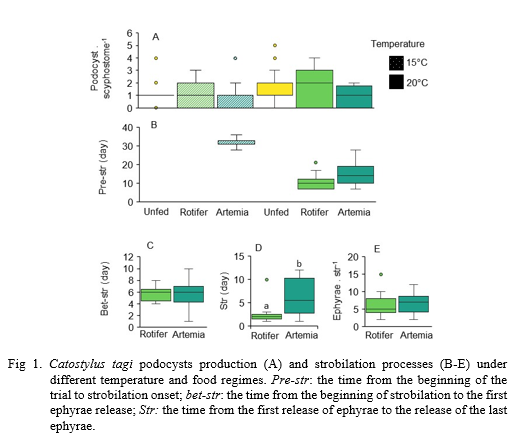CULTURE OF Catostylus tagi, A NEW EDIBLE JELLYFISH
Introduction
Jellyfish have been commonly considered a nuisance for human activities. However, some species bear potentials for food, cosmetic, pharmaceutical and biotechnology fields. Catostylus tagi, a jellyfish common in the western Atlantic and Portuguese coasts, holds several biochemical properties along to be edible for human consumption (Raposo et al., 2018; Amaral et al., 2018). Its collagen and antioxidant properties showed a potential new bio-resource for the cosmetics and food sector (Calejo et al., 2009; Morais et al., 2009). While local C. tagi fisheries might respond to the needs of the various sectors, the ability to control its life cycle and biomass production might be the key for future sustainability in this rising new product.
Materials and methods
Catostylus tagi specimens were samples and in vitro fertilisation performed in different temperature, salinity and light conditions. Once the planula obtained, different trials were performed investigating the optimum conditions (temperature, salinity and food type) for planula survival and settlement, polyps development, and asexual reproduction (podocyst, strobilation and ephyra production). The life cycle of the species was also documented from the planula to the juvenile stage.
Results
Catostylus tagi displays the typical Rhizostomida metagenetic life cycle. The results showed a high tolerance of the different life stage to the wide range of salinities and temperatures. The planula settlement was significant influenced by temperature (P < 0.001) and salinity (P < 0.01), but no interaction was detected (P = 0.31). Polyp development was enhanced at higher temperature with an optimum of 25 °C and all salinities. Among the asexual reproduction, only the strobilation processes were significantly influenced by temperature and food type (P < 0.01) (Figure 1).
Discussion and conclusion
C. tagi displays a typical meta-genetic life cycle observed in Rhizostomatidae: a benthic scyphistoma phase that reproduces asexually via strobilation releases ephyrae that grow into a pelagic medusa, which reproduce sexually. The trials showed C. tagi high tolerance to a wide range of salinities and temperature. This plasticity reflects the species adaptation to estuaries conditions known for their highly dynamic environments, subject to rapid changes in the in situ conditions associated with varying freshwater flows.
While C. tagi appears as an euryhaline and eurytherm species, each stage (planula, polyps) and process (planula settlement, polyps development and strobilation, ephyrae production) responded distinctively to the different conditions. While the specifications of each stage need to be fulfilled to reach optimum production, the environmental plasticity makes C. tagi, among other jellyfish species, a good candidate for aquaculture
References
Amaral, L. et al. (2018) Jellyfish ingestion was safe for patients with crustaceans, cephalopods, and fish allergy. Asia Pac. Allergy, 8, e3.
Calejo, M. T. et al. (2009) Isolation and biochemical characterisation of a novel collagen from Catostylus tagi. J. Biomater. Sci. Polym. Ed., 20, 2073–2087.
Morais, Z. B. et al. (2009) Composition and in vitro antioxidant effects of jellyfish Catostylus tagi from Sado estuary (SW Portugal). J. Aquat. Food Prod. Technol., 18, 90–107
Raposo, A. et al. (2018) Eating jellyfish: safety, chemical and sensory properties. J. Sci. Food Agric., 98, 3973–3981
